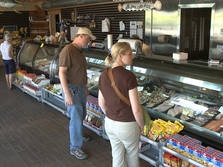Libby Carnahan,
Pinellas County Sea Grant Extension Agent
Seafood is an important part of a healthy, well-balanced diet. According to health experts, eating fish just two times a week can significantly help to reduce the risk of heart-related death. However, seafood markets can be overwhelming. Seafood can vary significantly by price, type, and origin. With so much variety, how do we make good choices when buying seafood?
With over 80 different varieties, including shrimp, lobster, tuna, grouper, and mahi mahi, Florida has many great options for the consumer. Florida is one of the most competitive and active seafood markets in the world, with commercial landings in 2009 of over 88 million pounds of seafood products with a dockside value of over $145 million (FWRI 2009 Commercial Landings Data).

There are many positive merits for the environment, the economy, and the community to purchasing local Florida Seafood. Florida fishermen are required to follow strict federal and state laws that help protect the long-term sustainability of domestic fisheries for future generations. Despite dramatic changes to many of Florida’s coastal communities in recent decades, several communities have maintained their traditional working waterfronts and continue to harvest, process and sell seafood. By investing in local fishermen, consumers help to strengthen their local communities.
Florida seafood, like all U.S. seafood (both domestic and imported) must also follow protocols to ensure the safety and quality of the product. Purchasing seafood from reputable licensed vendors helps to ensure products are harvested, processed and sold according to federal, state, and local regulations. To find where you can purchase Florida seafood products visit the http://www.fl-seafood.com/consumers/wheretobuy.htm page. Health experts recommend eating a variety of seafood to maximize its multiple health benefits and mitigate potential risks. By choosing different types of seafood, you also help reduce pressure on highly targeted species as well.
Typically buying locally harvested seafood will significantly reduce one’s carbon footprint as there are usually fewer steps involved in processing the product and it doesn’t have to travel as far to reach the consumer. However, in some cases it might not be possible to buy Florida-harvested seafood. The product might be out of season or unavailable, it could be too expensive, or it simply is not harvested in the area (i.e. salmon or sea scallops). When possible consider purchasing seafood products that are harvested regionally or in the U.S. to further support the long-term health and sustainability of domestic fisheries. To learn more about U.S seafood visit the http://www.nmfs.noaa.gov/fishwatch page.
Further Reading
Bryan Fluech, "Why Buy Local Seafood? The environmental and socio-economic benefits of eating Florida Seafood". http://collier.ifas.ufl.edu/SeaGrant/pubs/Benefits_of_Eating_Florida_Seafood_Fact_Sheet[1].pdf
Pinellas County Sea Grant Extension Agent
Seafood is an important part of a healthy, well-balanced diet. According to health experts, eating fish just two times a week can significantly help to reduce the risk of heart-related death. However, seafood markets can be overwhelming. Seafood can vary significantly by price, type, and origin. With so much variety, how do we make good choices when buying seafood?
With over 80 different varieties, including shrimp, lobster, tuna, grouper, and mahi mahi, Florida has many great options for the consumer. Florida is one of the most competitive and active seafood markets in the world, with commercial landings in 2009 of over 88 million pounds of seafood products with a dockside value of over $145 million (FWRI 2009 Commercial Landings Data).

There are many positive merits for the environment, the economy, and the community to purchasing local Florida Seafood. Florida fishermen are required to follow strict federal and state laws that help protect the long-term sustainability of domestic fisheries for future generations. Despite dramatic changes to many of Florida’s coastal communities in recent decades, several communities have maintained their traditional working waterfronts and continue to harvest, process and sell seafood. By investing in local fishermen, consumers help to strengthen their local communities.
Florida seafood, like all U.S. seafood (both domestic and imported) must also follow protocols to ensure the safety and quality of the product. Purchasing seafood from reputable licensed vendors helps to ensure products are harvested, processed and sold according to federal, state, and local regulations. To find where you can purchase Florida seafood products visit the http://www.fl-seafood.com/consumers/wheretobuy.htm page. Health experts recommend eating a variety of seafood to maximize its multiple health benefits and mitigate potential risks. By choosing different types of seafood, you also help reduce pressure on highly targeted species as well.
Typically buying locally harvested seafood will significantly reduce one’s carbon footprint as there are usually fewer steps involved in processing the product and it doesn’t have to travel as far to reach the consumer. However, in some cases it might not be possible to buy Florida-harvested seafood. The product might be out of season or unavailable, it could be too expensive, or it simply is not harvested in the area (i.e. salmon or sea scallops). When possible consider purchasing seafood products that are harvested regionally or in the U.S. to further support the long-term health and sustainability of domestic fisheries. To learn more about U.S seafood visit the http://www.nmfs.noaa.gov/fishwatch page.
Further Reading
Bryan Fluech, "Why Buy Local Seafood? The environmental and socio-economic benefits of eating Florida Seafood". http://collier.ifas.ufl.edu/SeaGrant/pubs/Benefits_of_Eating_Florida_Seafood_Fact_Sheet[1].pdf


 ShareThis
ShareThis







